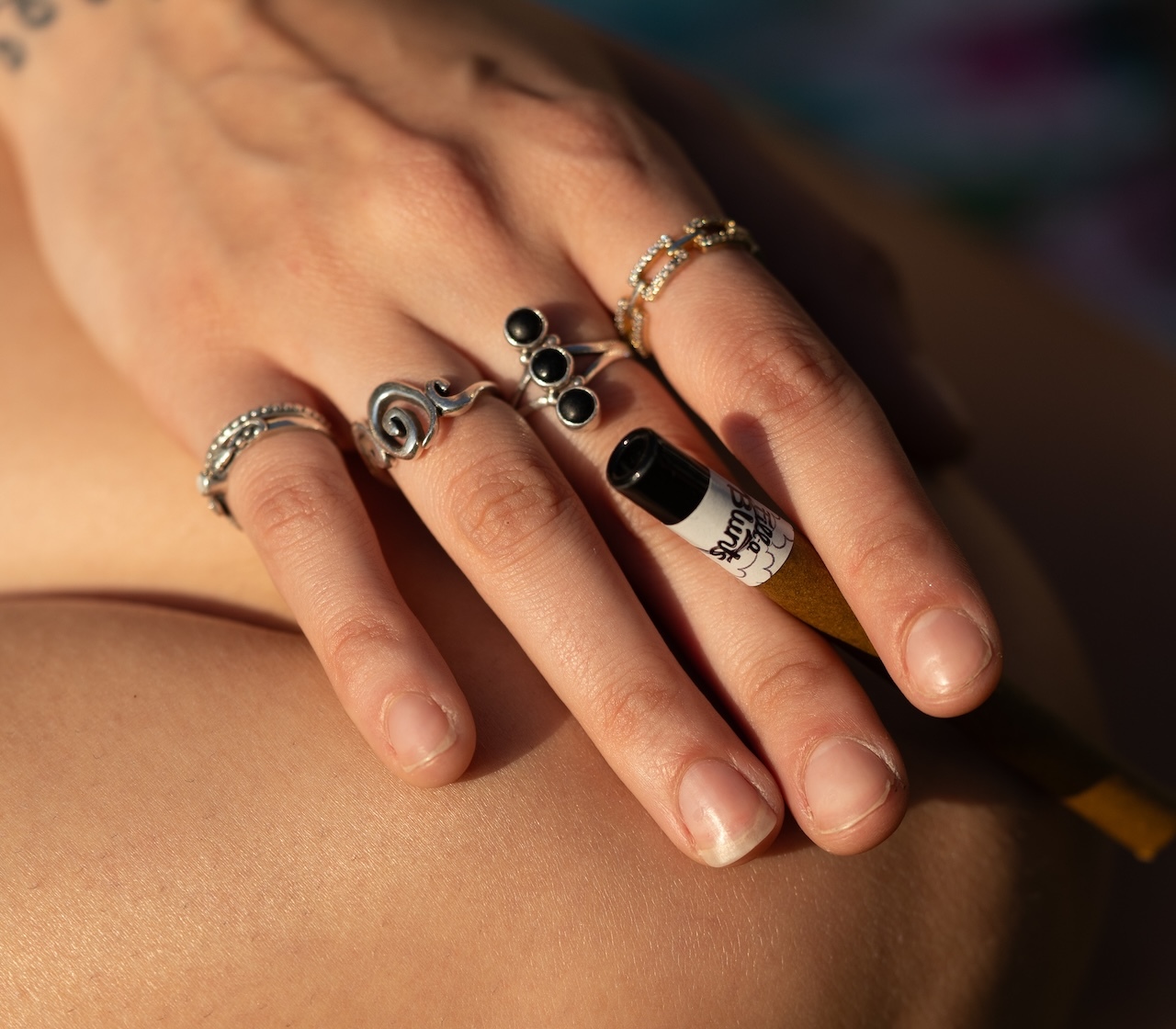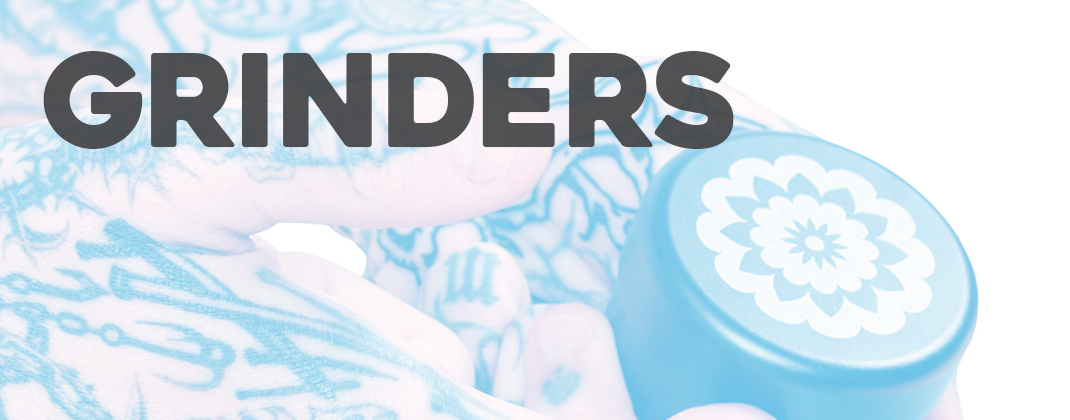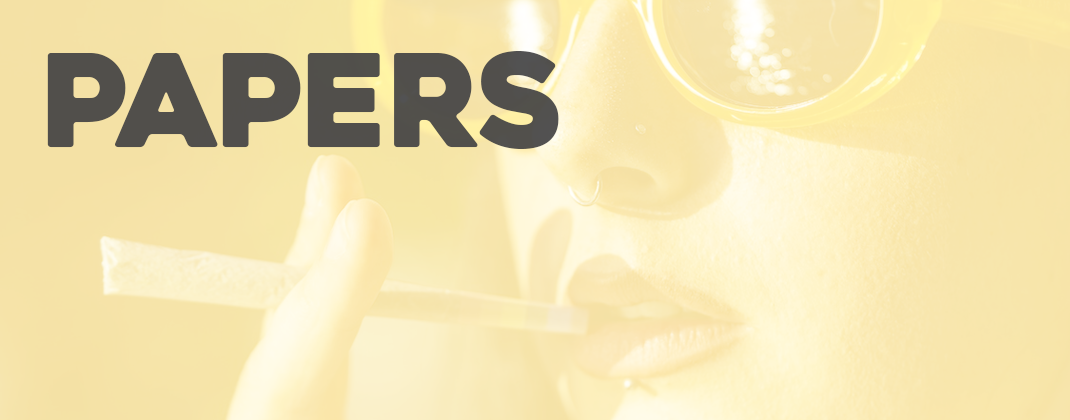The Ultimate Guide to Rolling Papers: History, Choices, and Insights
Posted by DaySavers Team on Jan 1st 2025
Author: Brian Beckley | Reviewed By: James Valentine
Rolling papers have been a staple of smoking culture for centuries, evolving into a diverse and nuanced accessory for both tobacco and cannabis enthusiasts alike.
Whether you're a seasoned smoker or a curious novice, understanding the history, sizes, materials, and advancements in rolling paper technology can help you find the papers that make sense for you to better elevate your experience.
So let’s roll through the basics of rolling papers and their place in smoking culture so you can choose the right way for you to Enjoy Your Day.
A Brief History of Rolling Papers
There are few things more universal in the cannabis world than a joint. In fact, according to recent data from New Frontier Data, joints are the most preferred method of consumption for 61% of consumers.
Because of that, it’s hard to think of a time before joints. But in the long history of cannabis use – which stretches back literally thousands of years – the joint is a modern invention.

For much of that time, people inhaled the smoke of cannabis plants through pipes, incense burners, or a myriad of other ways, but the joint itself – ground cannabis flower wrapped in paper and lit on one side – never appeared among ancient methods.
That's because the joint – and the pre-roll – can only be invented AFTER the rolling paper.
The history of rolling papers traces back to 16th-century Spain, where the practice of hand-rolling tobacco leaves originated. Back then, smoking was a luxury, and resourceful smokers used discarded pages of books or newspapers as makeshift wrappers. In 1764, a Spanish company called Pay-Pay began producing dedicated rolling papers, establishing one of the earliest known brands in the industry.
With tobacco from the “New World” becoming more and more popular in Europe, rolling papers became a sought-after commodity, particularly in Spain and France, where artisans began refining production techniques, with rolling papers often used as a marker of sophistication and social status.
France became a significant hub for innovation in the 19th century. One notable milestone was the invention of interleaved papers by Zig-Zag in 1894, allowing users to pull out one paper at a time with ease. Around the same time, brands began experimenting with materials like rice and flax, which improved the smoking experience by creating thinner and smoother papers.
The introduction of cigarette rolling machines in the late 19th century further cemented rolling papers as an integral part of smoking culture. These machines not only sped up production but also popularized pre-packaged rolling papers, making them widely accessible to consumers.
By the early 20th century, rolling papers had become an international phenomenon, with brands expanding into North America and other continents, with France becoming a major player.
As they gained in popularity, rolling papers made the easy transition from cigarettes to joints, particularly as cigarettes became more of a manufactured commodity, as opposed to ones rolled by the user.
Today, rolling papers come in a myriad of sizes, shapes, styles and colors and are also used to make products like pre rolled cones and pre rolled tubes for the modern cannabis industry, taking the rolling paper into the 21st century and beyond.
What are Rolling Papers Made Of?
Modern rolling papers are crafted from various materials, each with unique characteristics that affect burn quality, taste, and environmental impact.

Wood Pulp
Like traditional paper and traditional rolling papers, wood pulp is still the primary ingredient in most rolling papers. The wood pulp is refined to remove lignin, a polymer found in plant cells that give it structure. The amount of refining done to the pulp determines the color, with white rolling papers going through more processing than natural brown papers.
And unless specifically flavored, there is a minimal taste impact from wood pulp papers, making them the traditional choice for home rollers and packers everywhere, from beginners just learning to roll to the most experienced smokers out there.
Hemp
A more eco-friendly option, hemp rolling papers are a favorite of those for whom sustainability takes the fore. Made from the fibers of industrial hemp plants, which have a lower percentage of lignin than wood pulp, hemp papers often have a higher tensile strength and can be more difficult to tear than their wood-based cousins.
Hemp papers are usually light brown in nature and some smokers say that hemp papers have a subtle, earthy taste to them that compliments the flower (what with being from the same plant and all). They tend to burn slightly slower than wood-based papers, but just as smoothly and evenly.
At DaySavers, all of our hemp paper is organic, making it a favorite of environmentally-conscious smokers.
Flax
Another wood-pulp alternative, flax papers are made from the hair-like fibers of the flax, or linseed plant. The papers produced are often thin and silky in nature and tend to burn relatively slow compared to traditional wood-pulp.
Flax rolling papers too are almost completely flavorless and generally eco-friendly because they are made from the flax plant. However, because they are usually thinner, flax papers are often considered more difficult to roll, particularly for beginners.
Transparent Cellulose
It may look like these clear papers are made from plastic, but don’t worry, they are naturally derived from plants. Industrial cellulose is made mostly from wood pulp and then turned into thin, transparent sheets of what is called cellophane. But, again, don’t mistake it for the plastic wrap under your sink, this is a natural product.
It burns flavor-free and looks cool, but be warned, cellulose papers are notoriously difficult to roll with, so if you’re just learning the art of rolling, maybe start with the wood pulp or hemp and work your way up to cellophane.
Rice Paper
While “rice paper” – paper made of rice – is a real thing, it is generally only used in the culinary arts (think wontons). When it comes to rolling papers, it is a bit of a misnomer and a myth.
The term “rice paper” most often refers to white, ultra-thin rolling papers and is used as a descriptor of their thinness. However, most of those papers are actually just traditional rolling papers, made of wood-pulp and refined to be as thin as possible.
So you see, "rice paper” is generally a marketing term for ultra-thin white paper. In fact, because of recent lawsuits surrounding the truth in advertising on rolling paper booklets, some companies have removed the phrase “rice paper” from their products and made it clearer that these papers were always made from wood pulp.
White Vs. Brown Rolling Papers
In the rolling paper world, the main split is between papers that are bright white and those that have a more natural brown color.
But what exactly is the difference between them? And should you worry about bleached rolling papers?

Bleached Vs. Unbleached Rolling Papers
Like “rice paper,” “unbleached” rolling paper is another misnomer and more marketing language. In fact, bleach is not used at all in the modern rolling paper industry. The difference between brown and white rolling paper is simply in the amount of refinement the pulp goes through on the way to becoming paper.
As we noted, the wood pulp is refined to remove lignin – the polymer that helps give plants their structure. The more lignin removed, the lighter the color of paper. Put simply, the refining process was stopped earlier for brown papers, leaving more of the original plant material behind and creating that more natural-looking brown hue. Because of this, the natural brown papers are a little thicker and burn just a bit slower than the white.
Additional plant material left in the wood pulp to make paper also adds a subtle flavor to the natural brown that is not in the refined white, which also burns the cleanest and quickest, thanks to the refinements. Though the truth is, both the white and brown are generally flavor-free.
But again, white rolling papers are simply ultra-refined to create their bright color, not bleached.
Hemp Rolling Papers
Hemp rolling papers are also naturally more beige than white rolling papers, but not usually as dark as the natural brown rolling papers. At DaySavers, our hemp rolling paper is 100% organic and again, gets its color simply from the refinement of the hemp fibers used to make the paper.
Additionally, while the color of the hemp paper seems lighter than the Natural Brown, a closer inspection shows it to actually be more opaque than even the browns, meaning it is harder to see through. The hemp plant is known for its long and strong fibers, which results in the cloudier hemp paper.
Rolling Paper Thickness
So as we’ve noted, most rolling papers are made just like standard paper, but refined and made to be thinner for both rolling and smoking. But what do we mean by that? How thin is thin, exactly?
Paper thickness is measured in what is called grams per square meter, or gsm (sometimes written as g/m2). It’s a measure of the thickness and density of the paper, with a higher gsm meaning more sturdy paper.
- Standard copy paper, for example, usually has a gsm between 70 and 90.
- Business cards and brochures usually run between 100 and 150 gsm.
- Tissues and crepe paper generally come in between 10-35 gsm.
- Cigarette paper is about 28-30 gsm.
- Rolling papers tend to fall in the 12-15 gsm range, but there can be variance depending on the paper used.
At DaySavers, both our refined white and natural brown papers have a gsm of 12.5. Our organic hemp paper, however, clocks in at 13.5 gsm.
And if you’re wondering, the hemp wrap used to make Fill-a Blunts 2-Gram Fatty Hemp Wrap Blunt Tubes is 60 gsm and the hybrid hemp used for all of our hybrid hemp wrap blunt cones, as well as the green and pink hybrid hemp wrap 1 ¼ Artisan Tubes are 50 gsm.

Forms of Rolling Papers
While the individual sheet of rolling paper has been the standard since the late 19th century, the versatility of the product has led to a range of product forms available so discerning smokers can find what works best for the joints they want to roll.
So what all is out there? Let’s explore a bit.
Booklets
The primary way people buy rolling papers are in traditional booklets that allow for smokers to pull one sheet at a time. Rolling paper booklets vary in size depending on the paper you buy and the number of sheets, depending on the company.
Because of their slim nature and design, rolling paper booklets fit easily in a pocket or purse and they travel easily without the need for humidity packs or anything like that. But these days, some modern rolling papers companies are including more than just paper in their rolling booklets.
While some rolling paper booklets are designed simply to hold the rolling papers, other companies, like DaySavers include filter tips that can be pulled and rolled right into your joint, providing a sturdy crutch at the end so your joints don’t crush or stick together after you begin smoking them. Crutches also keep the stay flower out of your mouth.
But that’s not all. For our Smoke Temple line, which combines form and function to turn smoking accessories into an artform, we added a special collapsable rolling tray, built right into the book, as well as stylish, black pre-printed filter tips. Simply fold out the tray and you are ready to roll, no matter where you are.
How Many Papers Come in a Pack?
Most of the major rolling paper companies, including DaySavers, package their primary rolling papers in booklets of 32 leaves. It’s something of a standard and if you are imagining a rolling paper booklet in your mind, it’s probably got 32 leaves in it.
But there are other options. Some companies, for example, offer larger booklets of 50 as their main form or as larger versions of their standard rolling paper booklets. Other companies package hundreds of papers in a single pack.
Rolls
Though the single leaf is the primary form of rolling paper available on the market, rolling papers are also available in rolls, allowing smokers to choose how big they want their joints to be.
The rolls come in various widths and lengths, depending on the company and usually contain a gum line. The continuous roll of rolling paper allows the roller to decide exactly how much paper they want to use for their joints. It’s like the Fruit by The Foot version of Rolling Papers.
Rolling paper rolls are also good for people who want to roll non-traditional joints, such as folks who want to roll a cross joint at home, or even branch out into something crazier (though we still think the Smoke Temple Cross Cone is the way to go).
Pre Rolled Cones and Pre Rolled Tubes
For those who can’t or don’t want to roll their own, there are pre rolled cones and pre rolled tubes.
Made with rolling paper and usually including a filter or crutch, pre rolled cones and pre rolled tubes deliver everything you’d expect from your rolling papers, but without having to actually roll them yourself.
It’s the easiest way to make a pre-roll like those you’d find at a dispensary, but filled with the exact flower of your choice.
Pre rolled cones and tubes provide the same burn and flavor-free experience as the papers they are made with, but without the hassle of rolling and can even be purchased with premium filter tips, like a spiral, wood, flavored wood, glass or even ceramic that enhances the smoking experience without any additional work rolling.
Put simply, they are like the next evolution of rolling papers and they really are a win-win for smokers.
Rolling Paper Sizes: One for Every Occasion
Rolling papers come in a variety of sizes, each catering to different preferences and uses. Though not the only sizes available, here are the most common options:
Single Wide
Known as a “standard size,” but generally considered small for joint-rolling, the single wide size rolling paper is great for rolling up small, personal joints and pinners, but is limiting for sessions involving multiple smokers and are not the best to bring to a circle. These small papers are said to hold up to a half gram of flower, but at that size the paper gets a little difficult to shape and wrap, so generally single size papers are used for smaller smokes.
- Dimensions: 68-70mm x 34-36mm
- Holds: Up to a half-gram, depending on particles size and tightness of the roll.
- Best For: Individual use or smaller smokes.
- Features: Compact and easy to carry, ideal for minimalists.

1 ¼ Size
If not the “standard,” per se, the 1 ¼ rolling paper is perhaps the most common size rolling paper and the pack most people visualize when they think of rolling papers. It is called 1 ¼ not because of size, but because it is designed to hold about 25% (or ¼) more than the “single wide” size. In real world terms, these papers are great for rolling up about a half gram flower, with room for just a little extra.
- Dimensions: 76-78mm x 45-48mm
- Holds: A little more than a half gram, depending on particle size and tightness of the roll.
- Best For: Those who prefer slightly larger joints or cigarettes.
- Features: A versatile choice that balances size and portability.
King Size
These are the big ones, perfect for rolling up something to share with your circle. They are both longer and wider than the 1 ¼ and will hold up to a full gram, depending on how tight your roll is. The King Size rolling paper creates a joint that is longer, as well as fatter and makes for either an extensive personal session or is great at parties since it is big enough to ensure that everyone can puff, puff before they pass.
- Dimensions: 100-110mm x 55-60mm
- Holds: Up to a full gram
- Best For: Sharing or larger smokes.
- Features: Popular for social settings, offering a longer, smoother burn.
King Slim
The “King Slim” rolling paper is just what it sounds like: it is as long as a king size paper, but not as wide. Skilled rollers might be able to get a full gram in these papers, but most people will have trouble rolling that much flower into these papers, so for most these will hold between 0.7 and 1 gram. However, because of their size, they are still easy to pass and will hold enough to go around a circle a few times.
- Dimensions: 105-110mm x 44-46mm
- Best For: A stylish, longer option with less width.
- Features: Preferred by users looking for a refined and sleek aesthetic.
Extra Wide or Wide
Short and stout, these papers are basically a fatter version of the standard single size rolling paper. They share the same length, but are almost twice the width as a single paper and are said to hold about double the amount of flower, though as always, that relies on a skilled roller and will vary based on particle size of your grind.
- Dimensions: 76-78mm x 60-62mm
- Best For: Customizing width for thicker rolls.
- Features: Offers maximum flexibility for larger quantities of material.
Where to Buy Rolling Paper?
Rolling papers are just paper and can be sold literally anywhere. However, they are most often found in smoke shops, gas stations and convenience stores, usually near the tobacco products.
And since they contain no THC, rolling papers can also be sold online and shipped everywhere< directly from the companies that manufacturer them.
Harmful Additives in Rolling Papers to Avoid
While the basics of making rolling papers are the same the world over, the process is not necessarily regulated in the same ways and some manufacturers add chemicals or other artificial substances during production.
Here are a few harmful additives that you should watch for in your process:

Chlorine Bleach
Used as a whitening agent, chlorine is a common chemical that can be dangerous to your health. While the vast majority of rolling papers get their white color from an extensive refining process or the addition of oxygen to the wood pulp, chlorine has also been used to bleach paper – including rolling papers – to achieve a bright, white color.
However, chlorine can produce toxic potassium nitrate when smoked that can irritate the respiratory system, causing shortness of breath or coughing fits, as well as potential longer-term complications from repeated use. Also, it tastes terrible.
When buying rolling papers, always look for papers that are free of chlorine.
Potassium Nitrate
Like chlorine, most modern rolling paper manufacturers do not use potassium nitrate as part of their process. The chemical can not only irritate the respiratory system, burning it can release toxic byproducts that can also damage the lungs, and its combustion can lead to the creation of carcinogenic compounds.
However, potassium nitrate was used historically as a burning agent or accelerant because it made the papers easier to light and works to regulate the burn rate, helping prevent the paper from burning unevenly or too quickly.
Titanium Oxide
Titanium Oxide (or titanium dioxide) kind of combines the previous two chemicals. It is used as a whitening agent, as well as to help regulate the burn rate. It is a common substance used in cosmetics and some foods, but when inhaled – particularly when combusted – can be dangerous.
Breathing it in can damage the lungs and respiratory tract, potentially even causing long-term damage. It is also considered a potential carcinogenic when inhaled in high concentrations.
Artificial Dyes
Though they make rolling papers look pretty, artificial dyes also come with the potential for health issues, particularly when combusted and inhaled.
Some artificial dyes use heavy metals, like lead or cadmium, or petroleum-based chemicals, all of which can be harmful if inhaled, increasing the risks of cancer. For those that are not carcinogens, they can irritate the throat and lungs and even contribute to long-term health issues.
Calcium Carbonate
Calcium carbonate, or chalk, is another substance that can be used to make rolling papers burn slower. It is also used as a filler in cheap rolling papers to help lower production costs and improve durability of rolling papers.
While generally safe for most applications, burning and smoking it does raise some concerns. When combusted, calcium carbonate can break down into calcium oxide (quicklime) and carbon dioxide, both of which can irritate the lungs and airways. And because calcium carbonate doesn’t fully burn, it could result in residue or heavier ash that may not be ideal for smoking.
Soy Coloring
While food-grade inks like soy coloring are considered safe to ingest, a recent study by Lake Superior State University has identified high levels of copper in soy inks, presenting a questionable situation before you've even lit up"
Safe Ingredients in Rolling Papers
Not every additive to rolling papers is harmful though. Here are a few that are perfectly safe:
Gum Arabic
Gum Arabic is a natural adhesive widely used to create the glue strip on rolling papers. It is derived from the hardened sap of the Acacia tree, so it is plant-based, non-toxic and water-soluble adhesive.
Widely used in the food industry and recognized as safe by the FDA, gum arabic contains no harmful chemicals and does not release any harmful byproducts when combusted. It is also biodegradable, flavorless and odorless, making it perfect for use in high quality rolling papers.
Types of Glue Used in Rolling Papers
The adhesive strip on rolling papers plays a crucial role in ensuring a secure and even roll. Here are the most common types of glue used in rolling papers:
-
Natural Gum Arabic
- Source: Derived from the sap of Acacia trees.
- Characteristics: All-natural, vegan, and widely used.
- Advantages: Provides a strong and reliable seal while being environmentally friendly.
-
Sugar-Based Glue
- Source: Created from natural sugars.
- Characteristics: Completely edible and dissolves easily.
- Advantages: Offers a smooth seal with no harsh chemicals, enhancing the natural smoking experience.
-
Cellulose-Based Glue
- Source: Plant-derived cellulose.
- Characteristics: Transparent and lightweight.
- Advantages: Blends seamlessly with ultra-thin papers, maintaining their aesthetic appeal.
-
Synthetic Glue
- Source: Chemically engineered adhesives.
- Characteristics: Rarely used in high-quality rolling papers.
- Advantages: Durable but not as natural or environmentally friendly as other options.
When choosing rolling papers, understanding the type of glue can help ensure a cleaner and more enjoyable smoking experience.
Rolling Papers Vs. Wraps
In the cannabis world there are two main ways to wrap your flower for smoking: rolling papers and wraps.
The difference between the two is quite simple: Rolling papers, usually used for pre-rolled cones and joints, are generally made with wood pulp while wraps, designed for blunts, are not.
Modern blunt wraps are usually made with hemp or other non-tobacco material like palm leaves. Blunt wraps are often much thicker than rolling papers.
And while some rolling papers are made with hemp as well, the refinement process to make hemp paper is much more extensive, resulting in a much thinner product. For example, hemp paper has a gsm of around 12-15 while hemp wraps clock in somewhere around 60 gsm.

How are Rolling Papers Manufactured?
After hundreds of years of refinement and experience, the process of making rolling papers is a pretty straightforward affair by this point, though it still requires a skilled hand and a careful eye for detail to produce the highest-quality rolling papers on the market.
- Materials and Sourcing
Sourcing the raw material begins with the decisions of the base material, which determines the paper's quality and performance.
- Wood Pulp: The classic white or brown papers, made from refined or unrefined wood pulp. Once sourced, the raw material is broken down into a pulp to extract fibers.
- Hemp: Made from hemp fibers, these papers are durable, naturally brown or beige, and have a slow, even burn.
- Pulping and Refining
The raw material, whether hemp stalk or wood, is soaked and processed into a fibrous slurry. This slurry is then cleaned to remove impurities, and the degree of refinement determines the final paper color.
- Brown rolling papers are minimally refined and retain their natural look.
- White rolling papers undergo further refining and bleaching with oxygen or chlorine-free methods to achieve a cleaner appearance. Some papers, especially those labeled “unbleached,” are kept as close to their natural state as possible.
- Forming the Paper
The fibrous slurry is spread onto a fine mesh screen to allow water to drain and form thin sheets. This step uses a technique similar to traditional papermaking:
- The fibers bond together as they dry, forming the delicate sheets of rolling paper.
- To ensure an even burn, manufacturers may watermark the paper, a subtle imprint that regulates how the paper combusts.
- Once dried, the paper sheets are cut into precise sizes for rolling papers.
- Adding the Gum Line
To allow the paper to seal properly when rolled, a thin adhesive strip is applied along one edge. The most common adhesive is Gum Arabic, non-toxic, flavorless, and clean burning, ensuring a seamless smoking experience.
- Cutting, Packaging, and Quality Control
Finally, the rolling papers are cut into specific sizes (e.g., king-size, 1 1/4 size), stacked, and packaged. Each batch undergoes quality control to check for consistency in thickness, burn rate, and durability.
At DaySavers, we add one more step to the process: Lab Testing. All DaySavers products are tested to the strictest standards in the industry for pesticides, heavy metals and microbials to ensure that the paper you are smoking is as clean as the flower you roll into it.
How to Choose the Right Rolling Paper
Like most things, choosing the right rolling paper comes down to matters of personal preference. Some people like their paper to be as flavorless as possible, leaning toward white papers, while others prefer either the more natural look or slightly earthy taste of natural brown or even go with hemp papers because of a commitment to sustainability.
But beyond the type of paper you choose, there are some ways to determine the quality of the paper itself.
One of the main ways is what is commonly known as “the match test.” Simply light a match and burn the rolling paper. The less ash remaining, the better the quality of the rolling paper.
How Do You Use Rolling Papers?
While rolling papers are used to make pre-rolled cones, the primary use for rolling papers is to roll cigarettes or joints. The process is fairly simple:
- Grind your Flower: You are going to want to make about 7-10 turns of a common hand-grinder to make sure your particle size is right.
- Prepare Your Crutch or Filter: This step is, of course, completely optional as many old school rollers skip the filter entirely in favor of the classic all-flower joint. But for those who want a little structure at the end of their joints, a filter or crutch is a must-have addition. Many rolling papers these days come with filter tips as part of their packaging.
Smoke Temple papers, for example, come with unique black filters printed with the Smoke Temple logo and an image of the Cross Joint. DaySavers rolling papers, on the other hand, have white filters pre-printed with the smiling sun logo. You can either roll the crutch into a spiral or create a classic “w” filter, like those found in pre-rolls. To create the “w”, fold up decent-sized chunks of the filter paper, then fold it back on itself accordion-style about three or four more times and then roll it into the remaining filter paper.
- Remove a rolling paper from the pack: No matter what size you choose, it is important to spread it flat with the gum line at the top of the paper and facing you. Add a crease about 1/3 of the way up the paper. This will provide a trough for your flower.
- Add your flower: Do your best to add it evenly along the length of the paper. It should sit in the fold you made and the size of the trough should help guide how much flower you can get into your roll.
- Shape the Joint: Using your thumbs and index fingers, roll the papers around the flower to compress it into a tube. This may take a little practice, but once you get the hang of it, it becomes like riding a bike.
- Tuck and roll: This is the trickiest part for most people. While rolling the joint to create its shape, tuck the bottom edge of the rolling paper in as part of your roll, using your thumbs to roll the joint up your hand and your fingers to help pull the top of the paper down into the roll. This will help create a tight roll. If you have trouble doing this while holding the joint, there is no shame in placing it on your rolling tray and rolling the joint with the back of the paper flat
- Moisten the glue line and seal: That’s it. You’re ready to smoke.

Signs of a Well-Rolled Joint
Your joint, if rolled properly, will be an even cylinder, with no tears and a straight glue line. There should be no divots or bends or curves. If there are, do not fret, it will still smoke, but the lack of a consistent density may lead to air pockets, which can lead to the joint canoeing, or burning unevenly down one side.Why Won’t My Rolling Paper Stick?
Generally, this is a problem with the glue line. First, make sure you rolled it in the proper direction, with the glue line at the top of the paper and facing you. If that is the case,perhaps you used too much moisture. Rolling paper glues are designed to work with minimal moisture – a quick lick of the tongue is all it should take.
If correcting those two things still does not help, perhaps the issue is the rolling paper’s and not yours. Not all companies use the same glue or the same amount of glue, so if your paper is not sticking to itself, simply try a different paper brand. Look for ones that use gum acacia.
If it’s still not working, perhaps it is just time to switch to pre rolled tubes and cones.
The Difference Between Rolling a Cigarette and a Joint
The main difference between hand-rolling a cigarette and a joint is the material you put into it and, potentially, the type of filter used.
Because of the nature of tobacco versus cannabis, rolling a cigarette is generally easier because tobacco is longer cut and easier to shape, compared to the particles created by grinding cannabis. Tobacco comes pre-shredded and ready for use and is much more forgiving in the shaping and rolling process.
When it comes to filters, cigarettes can be rolled with pre-made filters that resemble those found in machine-made cigarette, or without a filter, but very few are rolled with a paper crutch, like many joints are.
The Best Rolling Papers Out There
DaySavers
Sourced from the finest paper mills in Europe, and always tested to the strictest standards in the industry for pesticides, heavy metals and microbials, there is no finer paper on the market than DaySavers Rolling Papers.
Available in 1 Gram King Size and Half Gram 1 ¼ packs of refined white paper, Daysavers rolling papers are ultra-refined, never bleached and burn smooth and evenly. They also come with filter tips built into the pack, so you are always ready to roll.

Smoke Temple
At the intersection of art and craft, Smoke Temple Rolling Papers are designed for the discerning smoker. Sourced from one of the finest paper mills in France, Smoke Temple Rolling Papers combine form and function with refined-white, ultra-thin papers, available in both King Size and 1 ¼ Size.
Both packs come with unique black filter tips, printed with the Smoke Temple logo and an image of the Cross Joint, a magnetic closure and a built-in rolling tray that folds out so you always have a place to roll.
Fill-a Blunts
Though not technically rolling papers, Fill-a Blunts pre-rolled blunt tubes are made with European-sourced hemp and are also always tested for microbials, pesticides and heavy metals, making them one of the finest choices on hemp wrap blunt tubes on the market.
Raw
One of the OG’s of the industry, Raw papers are sourced from Spain. Raw papers are unbleached and refined to a translucent brown color, with a “RAW” watermark. They are available in multiple sizes and shapes, including rolls, and come both with and without filter tips, as well as in hemp paper.
Top
Top rolling papers are made in France and are easily recognized by their iconic yellow packets featuring a red and blue toy top. They are available in Single Wide and 1 ½ sizes and are popular in the Midwest.
OCB
Produced in France and widely popular in Europe, OCB papers come in a variety of sizes and colors including white, unbleached brown and organic hemp. The company also offers Flax papers under its “premium” line.
They are also available with filter tips built into the pack.
Zig Zag
The oldest of OG rolling paper brands, Zig Zag is credited with creating the standard leaf format we know and love today. The rolling paper brand’s standard size packet is so iconic it was parodied on the cover of Dr. Dre’s massive-selling and culture-defining album “The Chronic.”
Based in France, Zig Zag papers come in a wide range of sizes, paper types and packet types, including their original white, an unbleached variety, an ultra-thin option and organic hemp.
Celebrity Rolling Paper Brands
Though usually just branded versions of other rolling papers, several celebrities have entered the rolling paper market with brands of their own, including:
- Wiz Khalifa (Raw)
- Juicy J (Raw)
- Seth Rogan (OCB)
- Snoop Dogg
- Mike Tyson (Futurola)
Rolling Paper Accessories
Though perhaps the most important part of any joint rolling set-up, rolling papers are not the only accessory one should have in their ultimate stoner kit.
Joint Roller
For folks who can’t or don’t want to roll their own joints by hand, but still want the hand-rolled feel, a joint roller is the perfect accessory. Joint Rollers are small, portable devices that consist of two rollers connected by a rolling sleeve or mat and held together by a frame or base.
To use, load your ground flower into the hopper area created by moving the rollers apart and then bring the rollers together and roll the flower to create a cylinder of cannabis. Place the bottom of a rolling paper with the gum line at the top facing you and roll it into the machine, licking the glue line before it fully disappears. Give it another roll or two, open it up and remove your fully rolled joint.

Rolling Tray
Key to any rolling area, a rolling tray helps contain your flower and provides a flat, even surface on which to roll. Usually made from coated metal, rolling trays come in various shapes and sizes, including the DaySavers Fast Fill Rolling Tray that includes places to easily fill two pre-rolled cones, if rolling joints isn’t your bag.
Poking Stick
Usually made with wood, a good poking stick is the easiest way to make sure your weed stays packed into the ends of your joint. While pens, paper clips, paper packing tubes and other things can be used to tamp and poke, nothing works as well as a wood poking or tamping stick. They are easily cleaned and look great, particularly when paired with matching ashtrays.
Pre-Rolled Papers
For folks who don’t want to roll, but still want to smoke a joint, pre-rolled cones and tubes provide a simple and accessible way to pack your own pre-rolls at home. Made with the same rolling paper found in booklets, but shaped into a cone or tube and usually fitted with a filter of some kind, pre-rolled cones and tubes are a fast and easy way to recreate the joint experience without the work.
Simply choose your favorite paper type and cone size and fill it with ground flower, pausing from time to time to tamp down the flower or tap the filter end on a flat surface, such as a rolling tray or tabletop, to ensure an even pack.
Rolling Paper Alternatives
Though traditional and seemingly perfect for smoking cannabis, there are some who enjoy a good joint, but prefer alternatives to rolling papers.
Hemp Wraps
Blunt smokers, for example, prefer something a little thicker, slower burning and more flavorful to wrap their cannabis. Traditionally, cigar leaves serve this purpose, but health concerns have led many people away from tobacco products and on a search for a similar wrap.
The hemp wrap has become the primary non-paper wrap for smokers. Made of thick hemp (usually about 60gsm), hemp wraps burn slowly and add an earthy flavor, perfect for the modern blunt smoker.
Hybrid Hemp Wraps
Hemp wraps, however, are not perfect. Because they use water bonds to help strengthen and hold them together, when they dry, hemp wraps can get brittle quickly. Hybrid Hemp wraps were created to solve this problem.
Hybrid hemp wraps are made with a higher percentage of hemp fiber – about 75% - and because of that, rely less on water bonds for structure so they stay fresher longer but still have the same slow burn as traditional hemp wraps.
Questionable Wraps
Finally, we come to botanical rolling papers and wraps, made not from wood pulp or hemp fiber, but other natural substances like leaves. But while interesting and popular, these wraps can carry hidden dangers.
Palm Leaves
Palm Leaves are one of the most popular alternative wraps on the market. Made with the leaves of either the Cordia or Tendu trees, palm leaves tend to burn slower than rolling papers and add a robust, earthy flavor to the smoke.
However, because they are a natural product and because there are no testing requirements, palm leaves can contain unsafe levels of heavy metals or pesticides, collected from the soil and/or sprays to keep off insects. In 2021, for example, SC Labs found that several store-bought palm wrap brands failed testing for pesticides. The following year, Colorado recalled palm blunt tubes because of unsafe levels of mold and yeast.
We’ve been unable to find a consistent source of clean palm leaves, which is why DaySavers does not sell palm leaf products.
Rose Petals
Similarly, rose petals are a popular alternative to traditional rolling papers. They look good, have a lovely scent, and are particularly popular around Valentine’s Day.
But like palm leaves, rose petals are a natural product and untested. Pesticides are a key part of commercial rose growing, for example, which is not a problem when the flowers are just used to look pretty. However, lighting and smoking those same petals can deliver those pesticides right into your lungs.
Again, like palm leaves, we’ve been unable to find a reliably clean source of rose petals, so DaySavers does not carry any rose petal products.
Specialty Rolling Papers: Beyond the Basics
 Flavored Papers
Flavored Papers
- Infused with fruit, dessert, or herbal flavors.
- Popular for masking the taste of harsh material.
- Ready-made shapes that eliminate the need for rolling skills.
- Perfect for beginners or on-the-go use.
- Made from edible gold leaf, offering luxury and style.
- Often used for special occasions.
- Designed to maximize the smoking duration.
- Ideal for social settings or savoring premium flower.
Environmental Impact: A Growing Concern
With the increasing focus on sustainability, many brands now offer eco-friendly rolling papers. Hemp and unbleached wood pulp are popular options, as they reduce the need for chemical processing. Recyclable packaging and carbon-neutral manufacturing processes are also becoming standard among leading brands.
At DaySavers, the hemp for our hemp paper and wraps is organically grown and all of our cones are FSC certified, meaning the paper is sustainably sourced.
Tips for Choosing the Right Rolling Paper
- Consider Your Skill Level: Beginners may prefer thicker papers or pre-rolled cones.
- Match the Material: Pair the paper’s burn rate and taste profile with your smoking material.
- Think About Size: Choose paper size based on your intended use, whether personal, social, or ceremonial.
- Experiment: Try different materials and brands to find your ideal match.
Conclusion: Roll with Confidence
Rolling papers are more than just a means to an end; they’re a personalized aspect of smoking culture. From their rich history to the wide array of choices available today, there’s a rolling paper for every preference and occasion.
Whether you’re drawn to the gleam of a refined white roll, the eco-friendly appeal of hemp, the natural look of brown paper or the convenience of pre-rolled cones, understanding your options will help you make the most of your smoking experience so you can Enjoy Your Day!
Brian Beckley spent 20 years as an award-winning newspaper journalist and editor, covering cities on both coasts before becoming Managing Editor of Marijuana Venture magazine, where he covered all aspects of the cannabis industry for five years. In his role with the magazine, he spoke at numerous cannabis conferences and hosted several media panels. Brian joined DaySavers as lead copywriter in 2023.
Rolling papers have been a staple of smoking culture for centuries, evolving into a diverse and nuanced accessory for both tobacco and cannabis enthusiasts alike.









